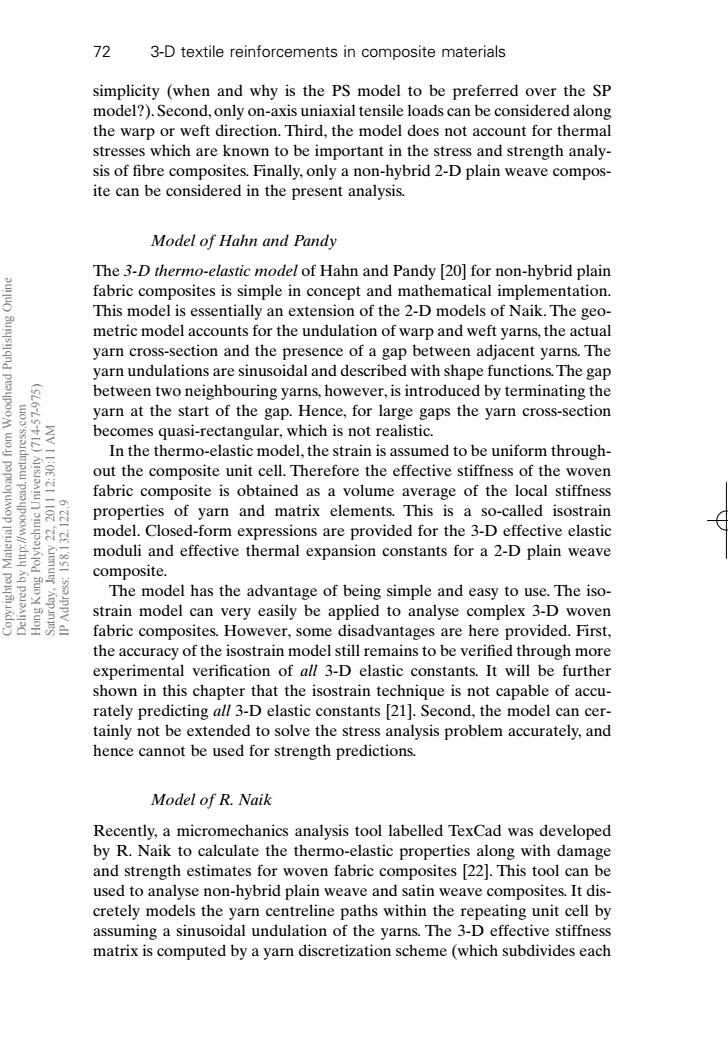正在加载图片...

72 3-D textile reinforcements in composite materials simplicity (when and why is the PS model to be preferred over the SP model?).Second,only on-axis uniaxial tensile loads can be considered along the warp or weft direction.Third,the model does not account for thermal stresses which are known to be important in the stress and strength analy- sis of fibre composites.Finally,only a non-hybrid 2-D plain weave compos- ite can be considered in the present analysis. Model of Hahn and Pandy The 3-D thermo-elastic model of Hahn and Pandy [20]for non-hybrid plain fabric composites is simple in concept and mathematical implementation. This model is essentially an extension of the 2-D models of Naik.The geo- metric model accounts for the undulation of warp and weft yarns,the actual yarn cross-section and the presence of a gap between adjacent yarns.The yarn undulations are sinusoidal and described with shape functions.The gap 5 between two neighbouring yarns,however,is introduced by terminating the yarn at the start of the gap.Hence,for large gaps the yarn cross-section becomes quasi-rectangular,which is not realistic. In the thermo-elastic model,the strain is assumed to be uniform through- out the composite unit cell.Therefore the effective stiffness of the woven fabric composite is obtained as a volume average of the local stiffness properties of yarn and matrix elements.This is a so-called isostrain model.Closed-form expressions are provided for the 3-D effective elastic moduli and effective thermal expansion constants for a 2-D plain weave composite. The model has the advantage of being simple and easy to use.The iso- strain model can very easily be applied to analyse complex 3-D woven fabric composites.However,some disadvantages are here provided.First, the accuracy of the isostrain model still remains to be verified through more experimental verification of all 3-D elastic constants.It will be further shown in this chapter that the isostrain technique is not capable of accu- rately predicting all 3-D elastic constants [21].Second,the model can cer- tainly not be extended to solve the stress analysis problem accurately,and hence cannot be used for strength predictions. Model of R.Naik Recently,a micromechanics analysis tool labelled TexCad was developed by R.Naik to calculate the thermo-elastic properties along with damage and strength estimates for woven fabric composites [22].This tool can be used to analyse non-hybrid plain weave and satin weave composites.It dis- cretely models the yarn centreline paths within the repeating unit cell by assuming a sinusoidal undulation of the yarns.The 3-D effective stiffness matrix is computed by a yarn discretization scheme(which subdivides eachsimplicity (when and why is the PS model to be preferred over the SP model?). Second, only on-axis uniaxial tensile loads can be considered along the warp or weft direction. Third, the model does not account for thermal stresses which are known to be important in the stress and strength analysis of fibre composites. Finally, only a non-hybrid 2-D plain weave composite can be considered in the present analysis. Model of Hahn and Pandy The 3-D thermo-elastic model of Hahn and Pandy [20] for non-hybrid plain fabric composites is simple in concept and mathematical implementation. This model is essentially an extension of the 2-D models of Naik. The geometric model accounts for the undulation of warp and weft yarns, the actual yarn cross-section and the presence of a gap between adjacent yarns. The yarn undulations are sinusoidal and described with shape functions.The gap between two neighbouring yarns, however, is introduced by terminating the yarn at the start of the gap. Hence, for large gaps the yarn cross-section becomes quasi-rectangular, which is not realistic. In the thermo-elastic model, the strain is assumed to be uniform throughout the composite unit cell. Therefore the effective stiffness of the woven fabric composite is obtained as a volume average of the local stiffness properties of yarn and matrix elements. This is a so-called isostrain model. Closed-form expressions are provided for the 3-D effective elastic moduli and effective thermal expansion constants for a 2-D plain weave composite. The model has the advantage of being simple and easy to use. The isostrain model can very easily be applied to analyse complex 3-D woven fabric composites. However, some disadvantages are here provided. First, the accuracy of the isostrain model still remains to be verified through more experimental verification of all 3-D elastic constants. It will be further shown in this chapter that the isostrain technique is not capable of accurately predicting all 3-D elastic constants [21]. Second, the model can certainly not be extended to solve the stress analysis problem accurately, and hence cannot be used for strength predictions. Model of R. Naik Recently, a micromechanics analysis tool labelled TexCad was developed by R. Naik to calculate the thermo-elastic properties along with damage and strength estimates for woven fabric composites [22]. This tool can be used to analyse non-hybrid plain weave and satin weave composites. It discretely models the yarn centreline paths within the repeating unit cell by assuming a sinusoidal undulation of the yarns. The 3-D effective stiffness matrix is computed by a yarn discretization scheme (which subdivides each 72 3-D textile reinforcements in composite materials RIC3 7/10/99 7:37 PM Page 72 Copyrighted Material downloaded from Woodhead Publishing Online Delivered by http://woodhead.metapress.com Hong Kong Polytechnic University (714-57-975) Saturday, January 22, 2011 12:30:11 AM IP Address: 158.132.122.9